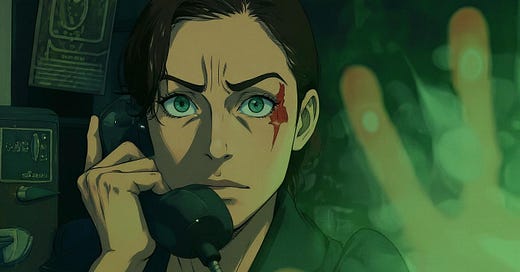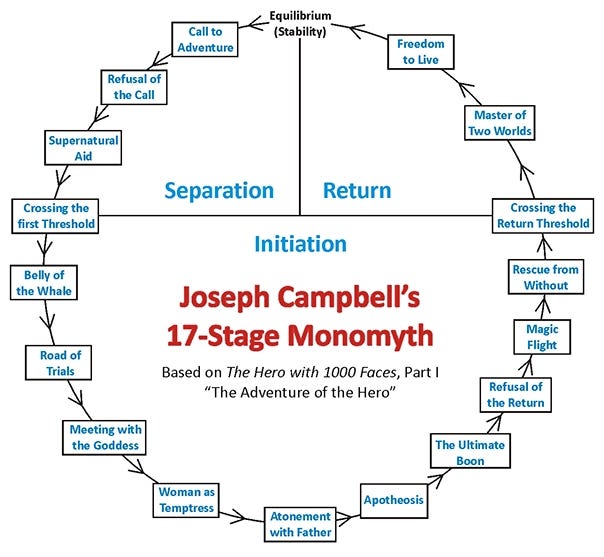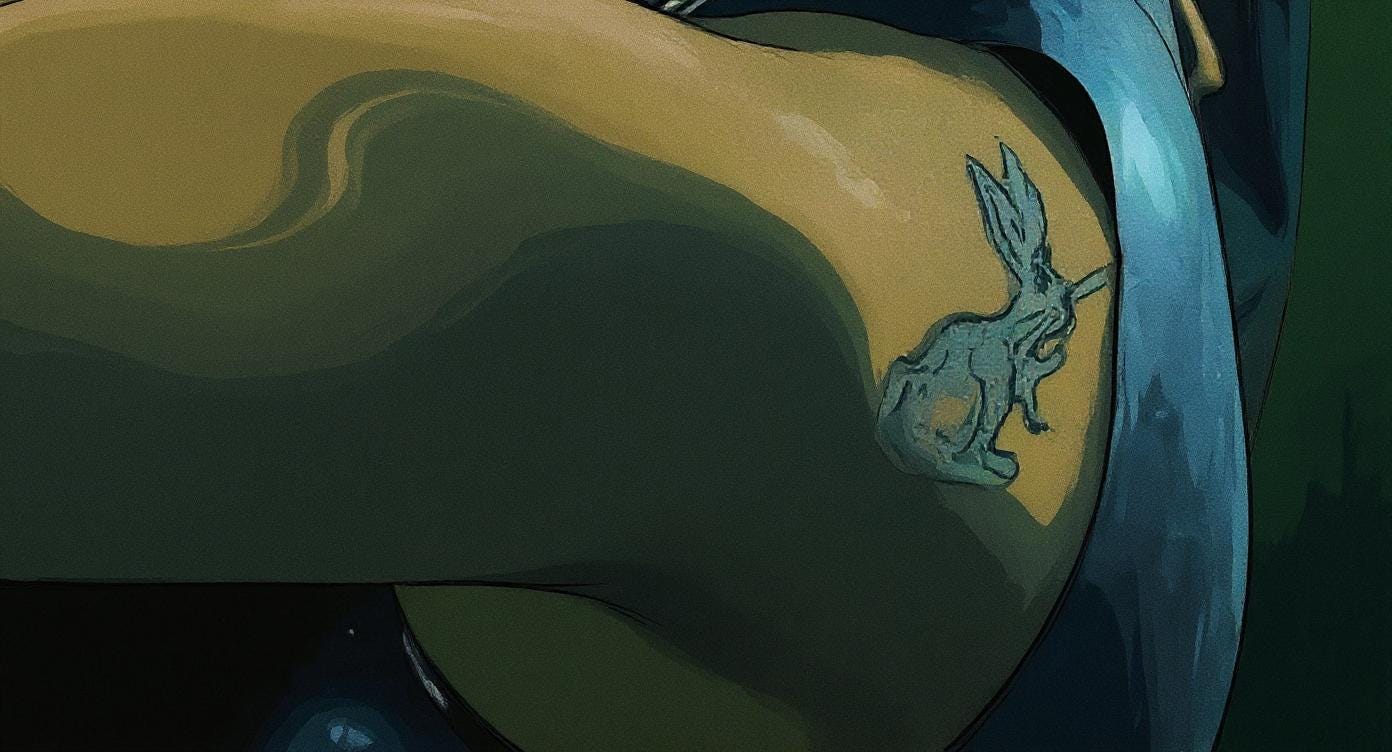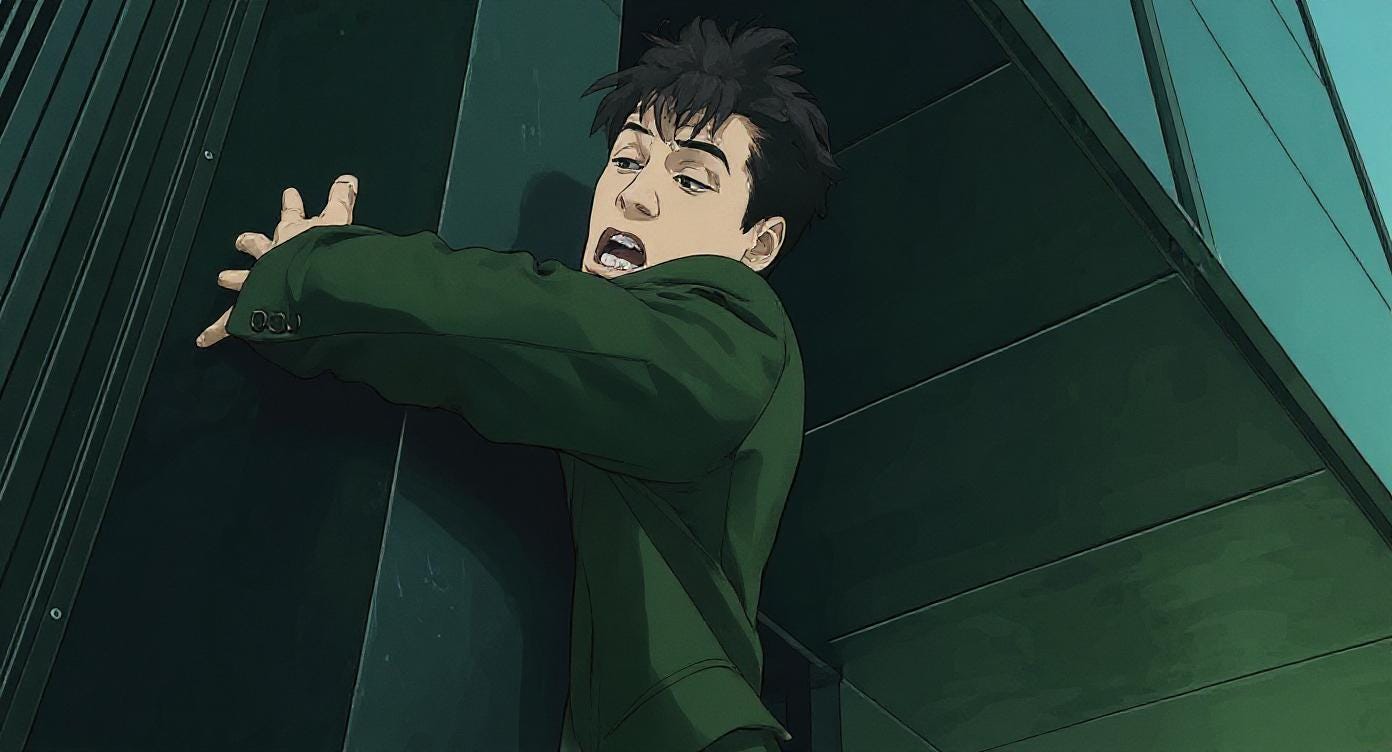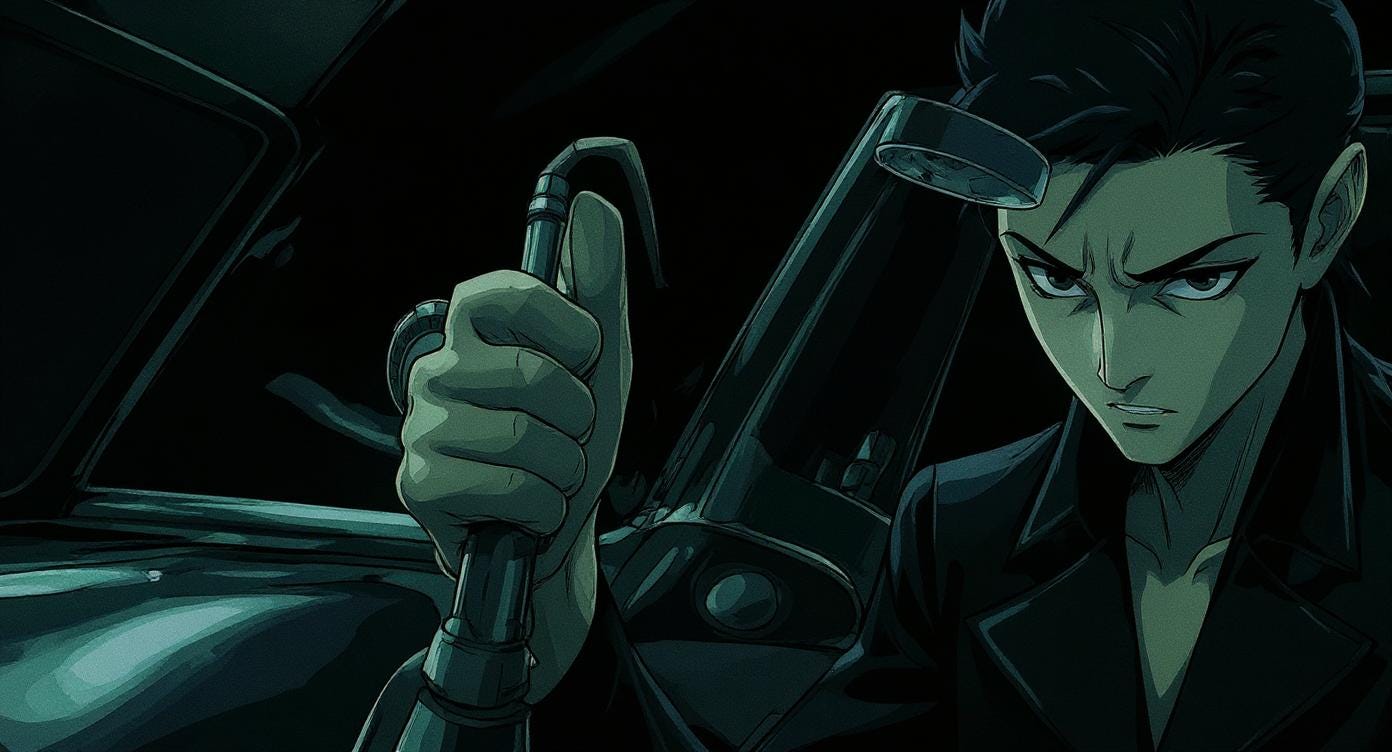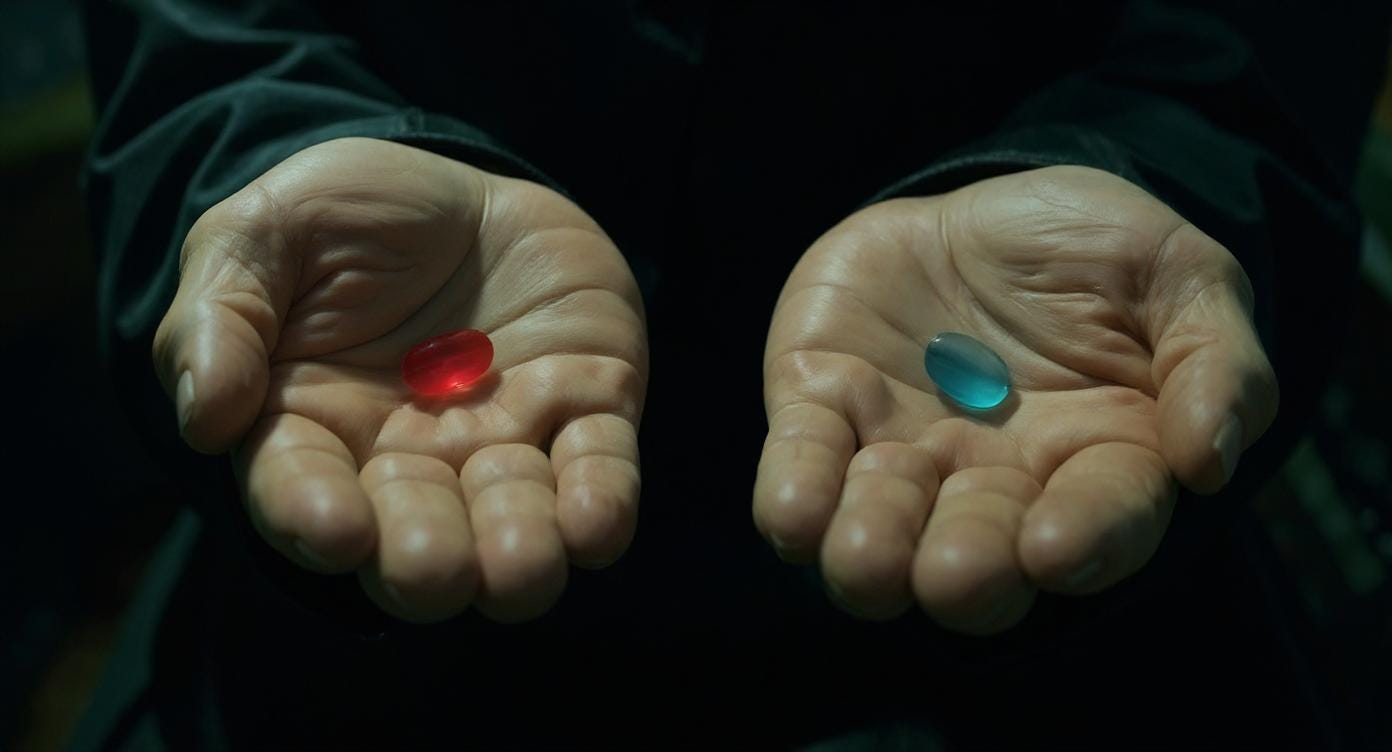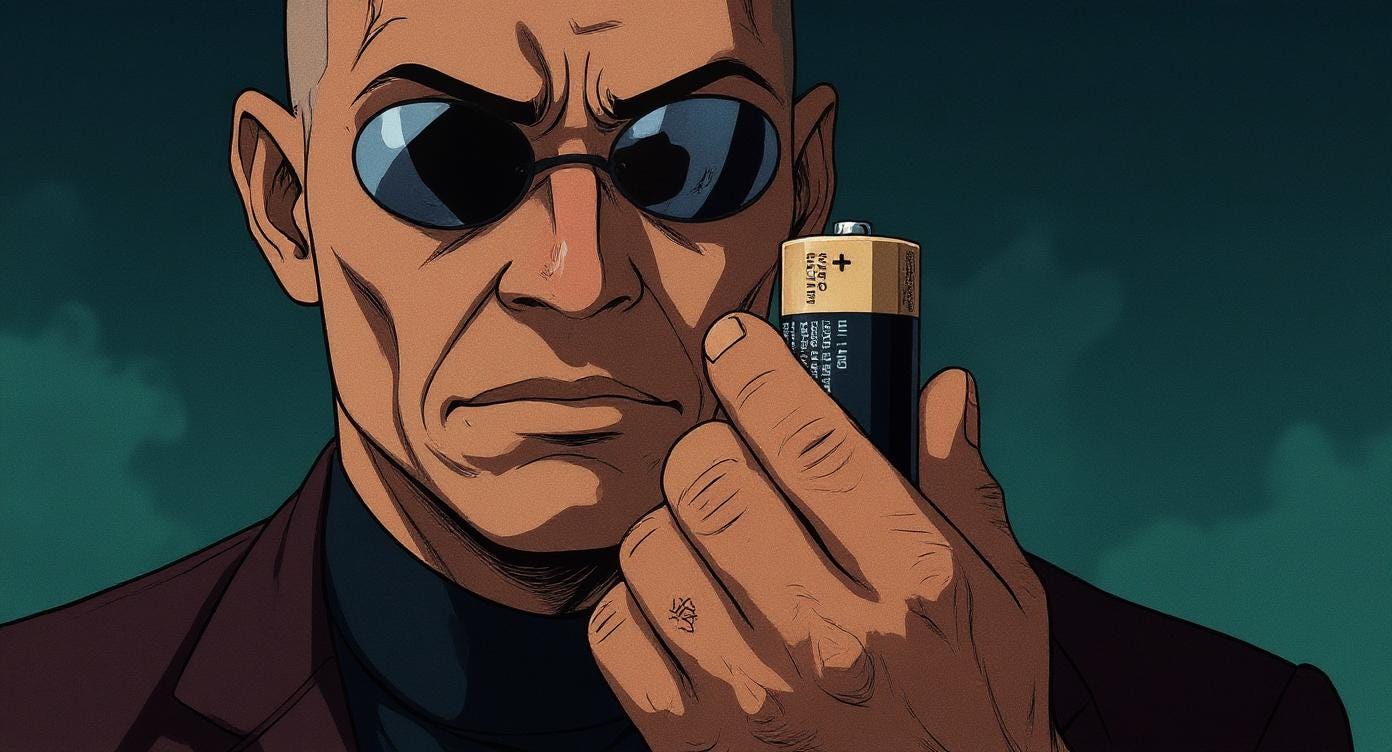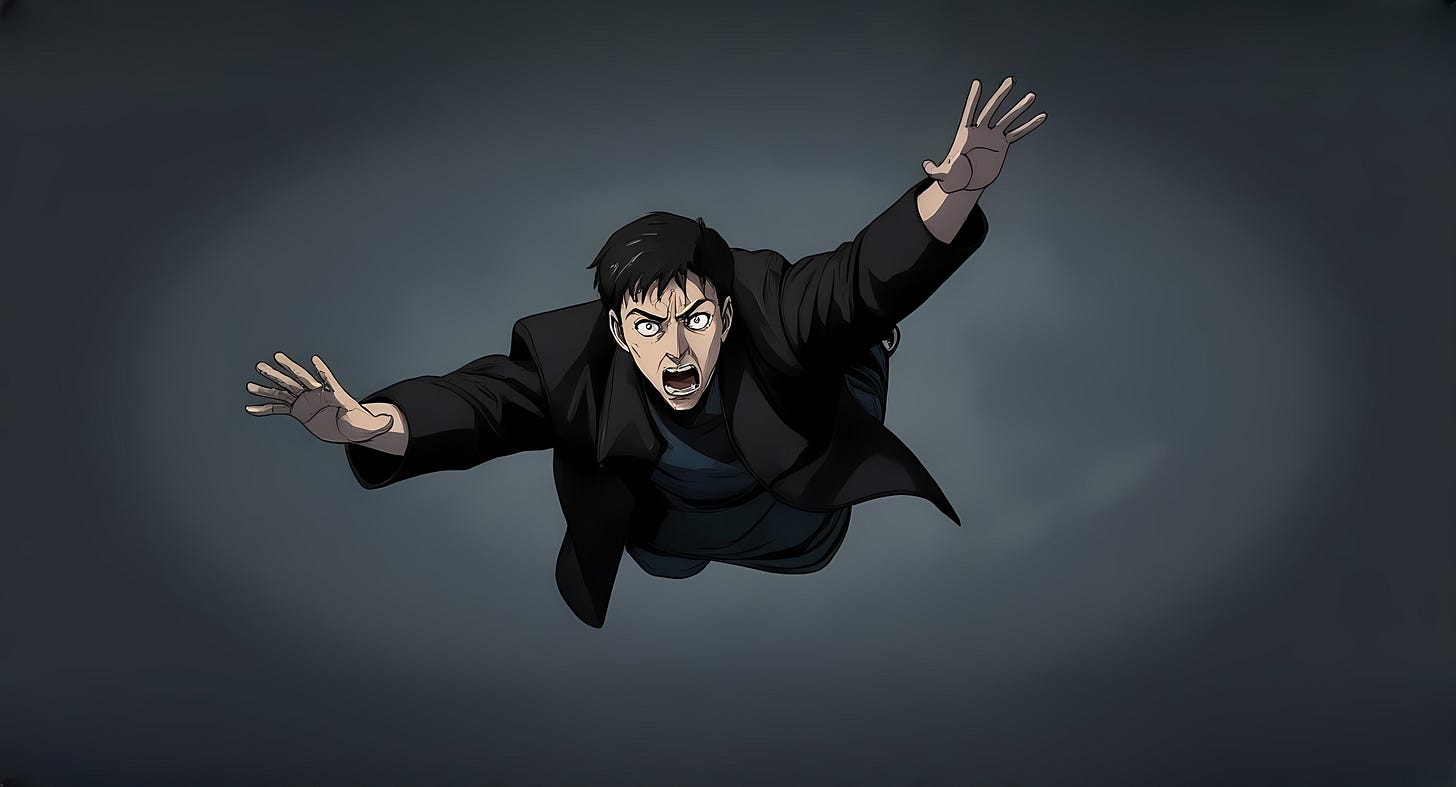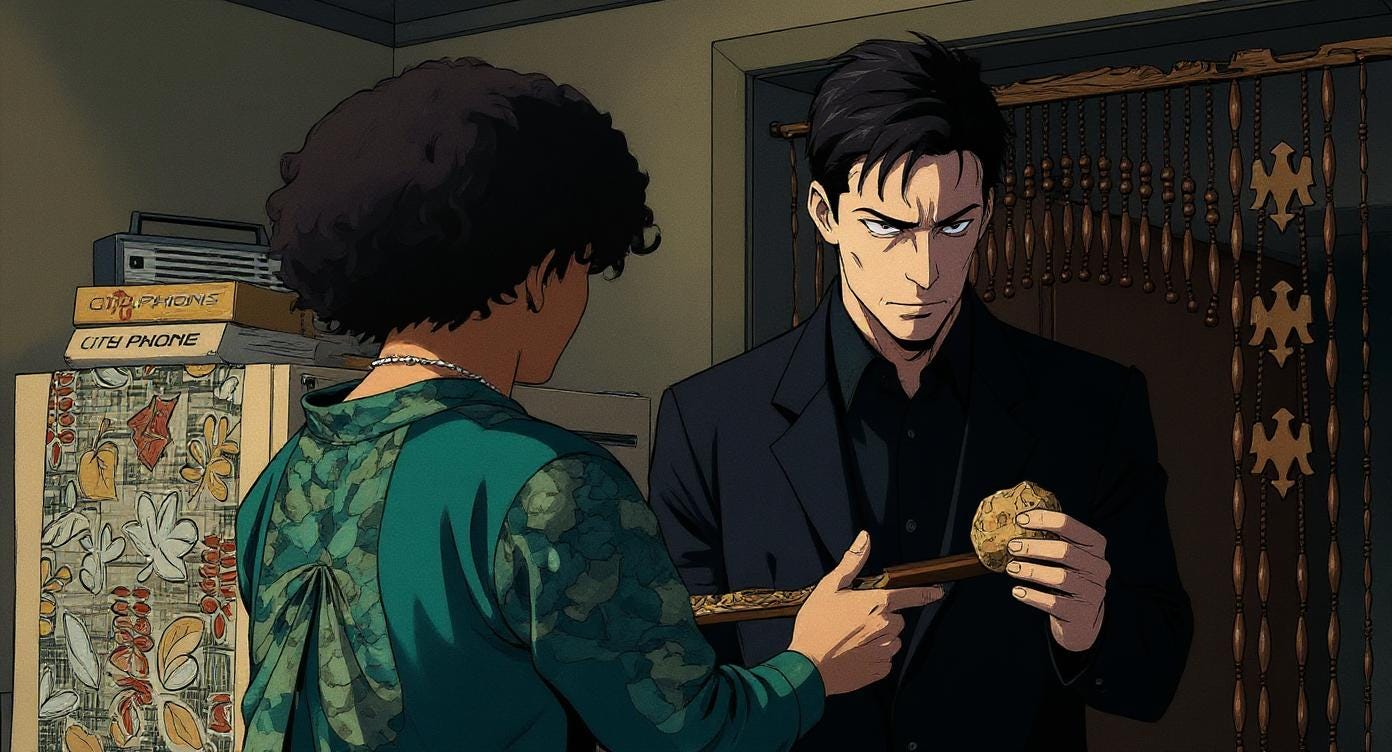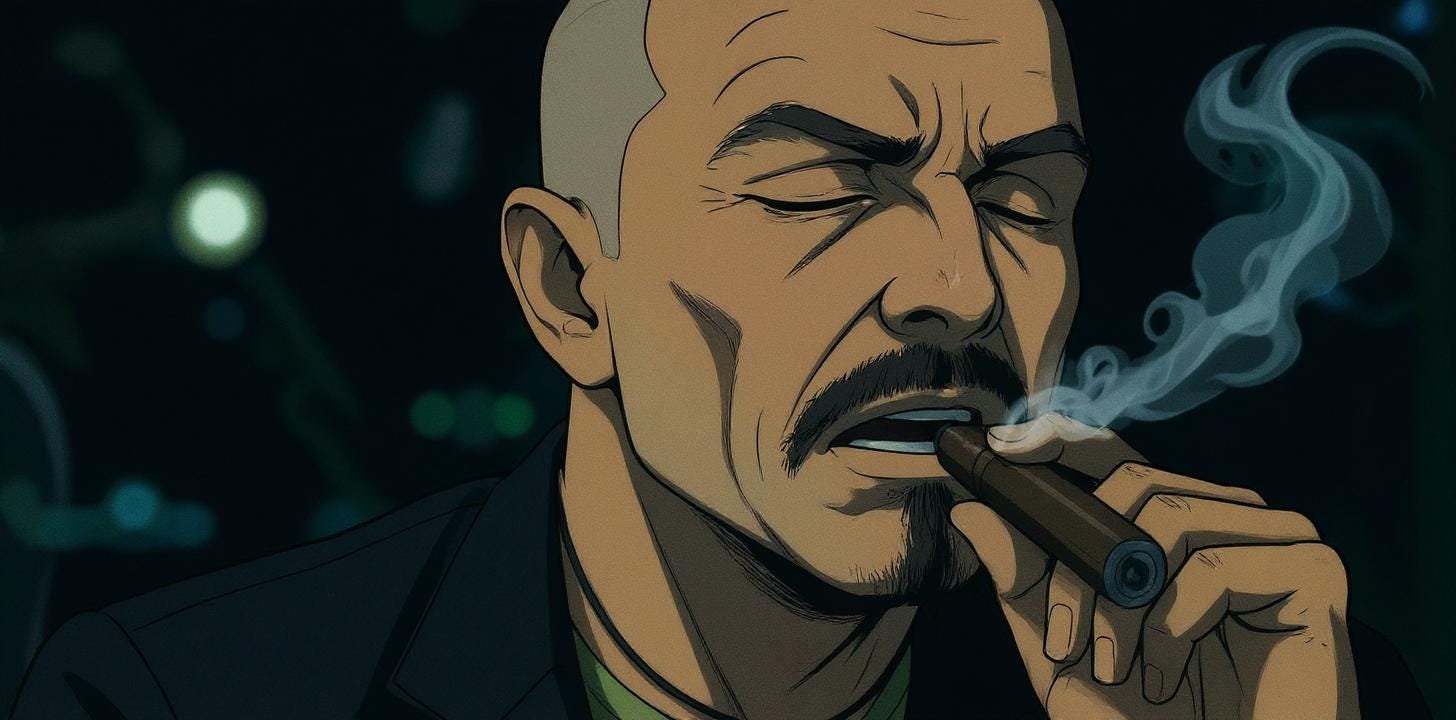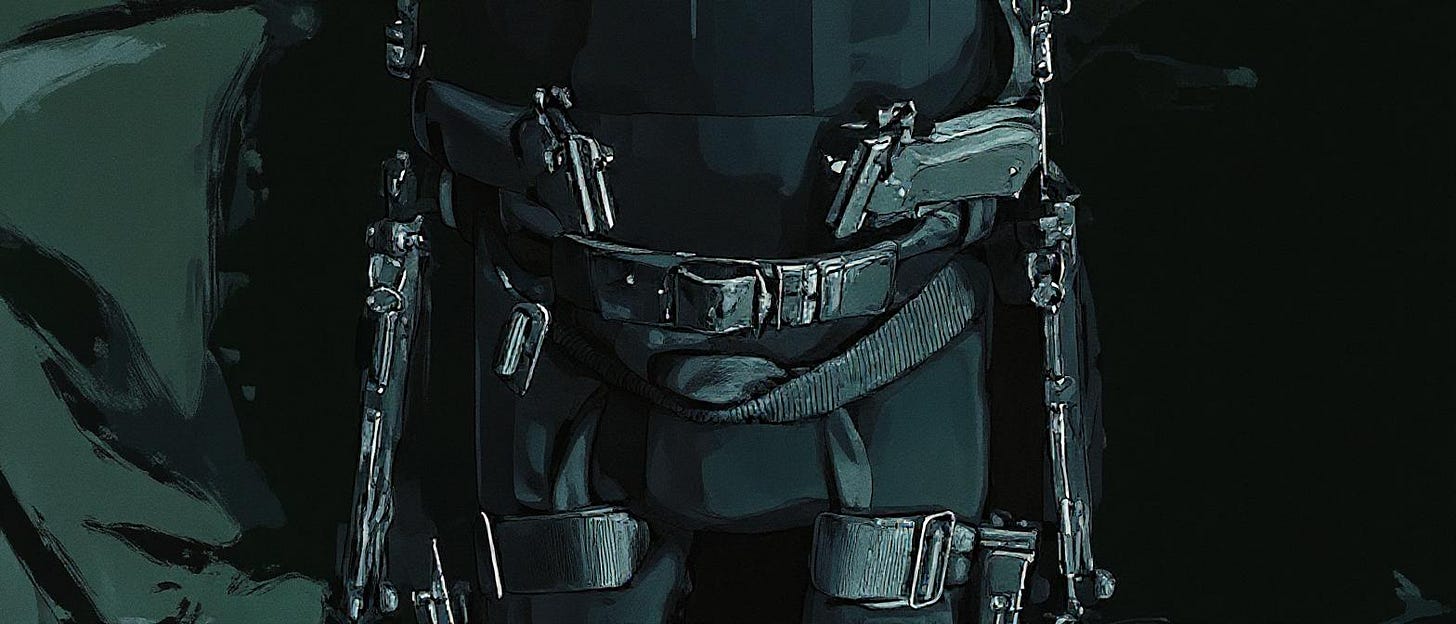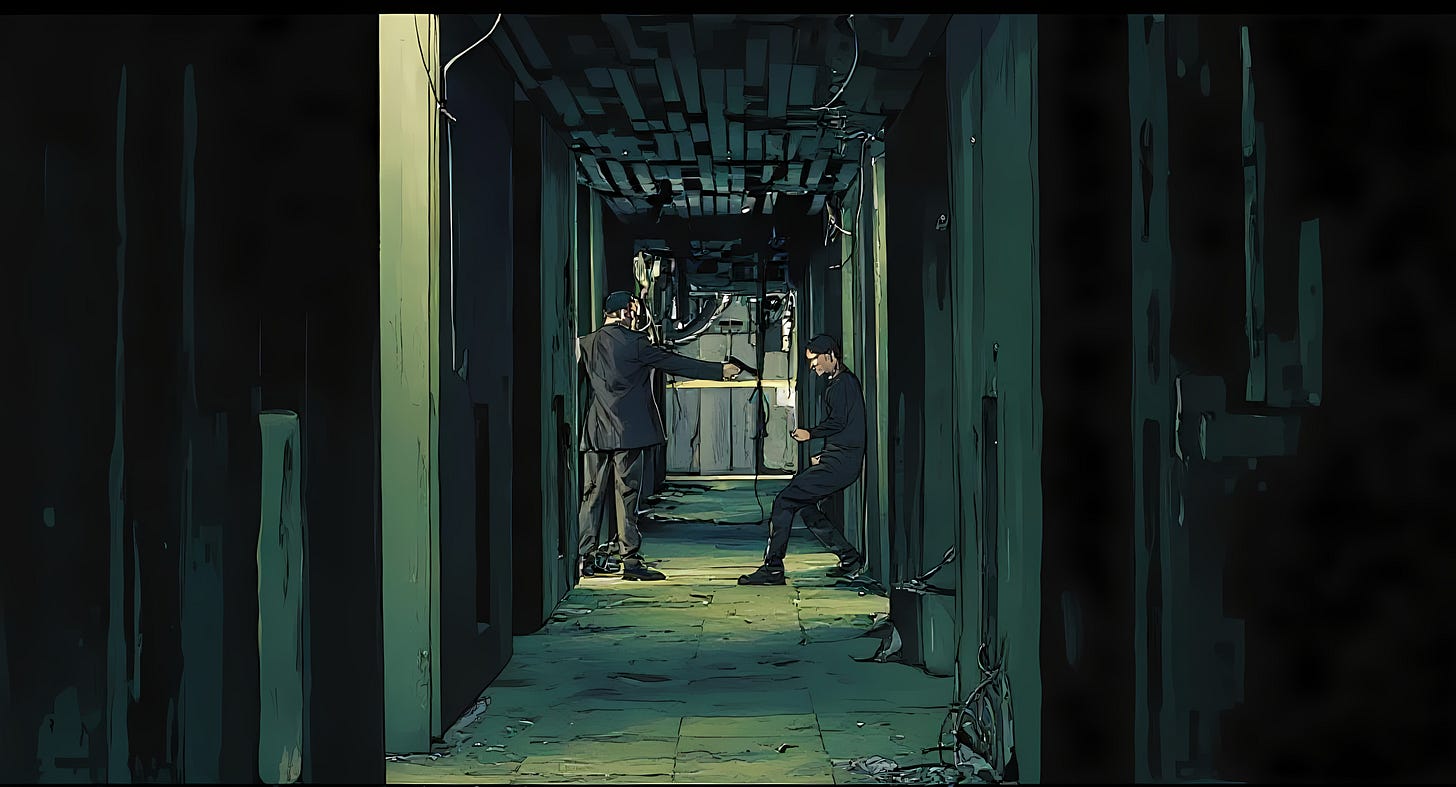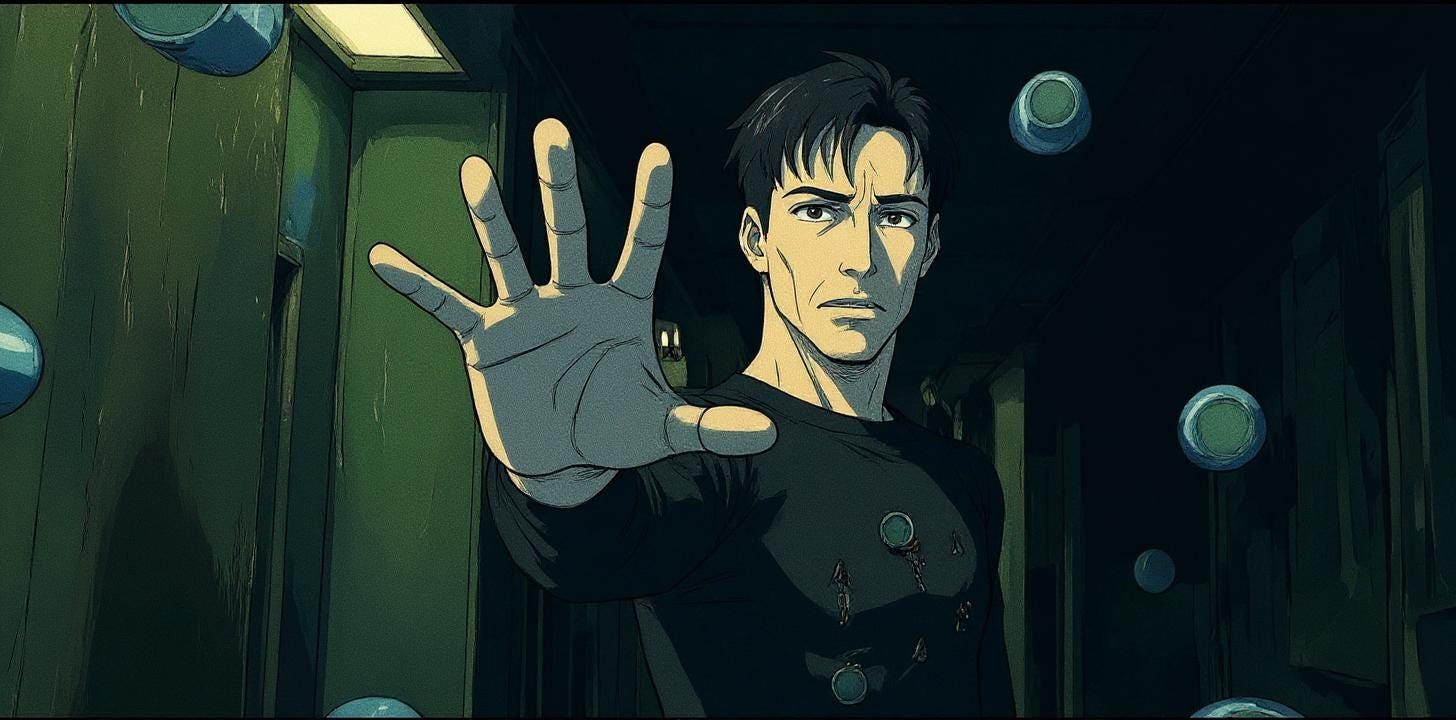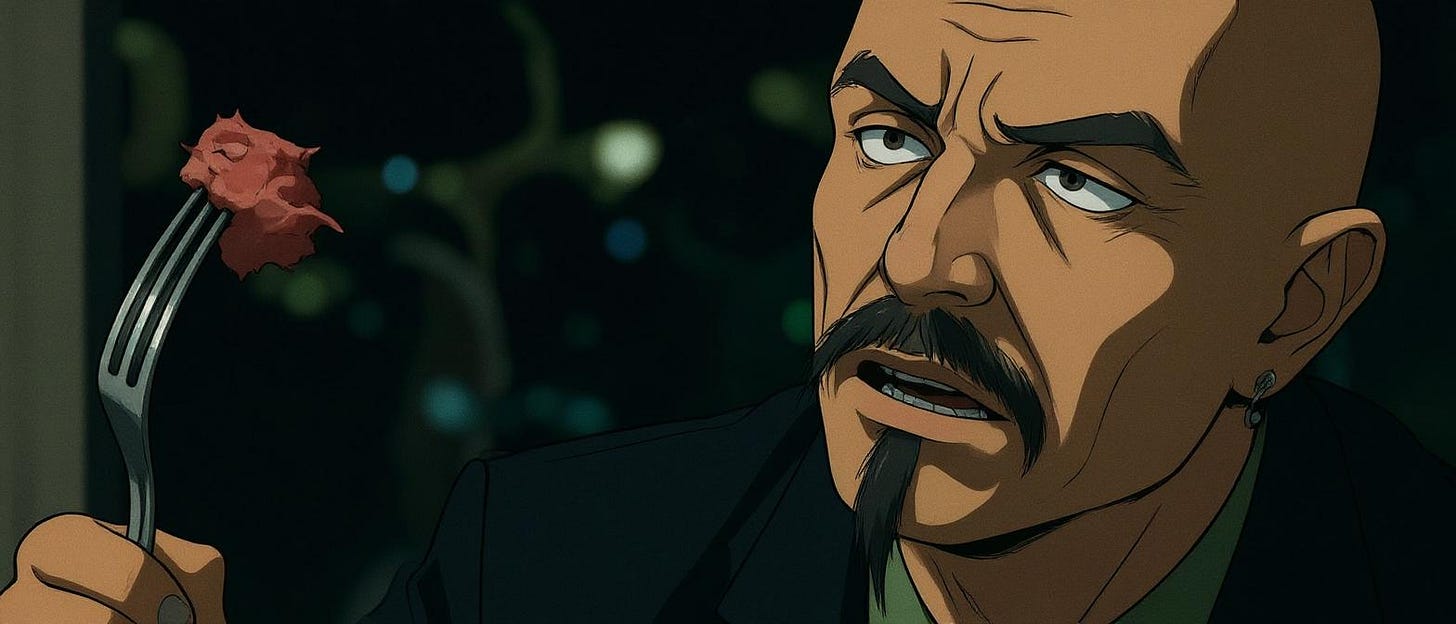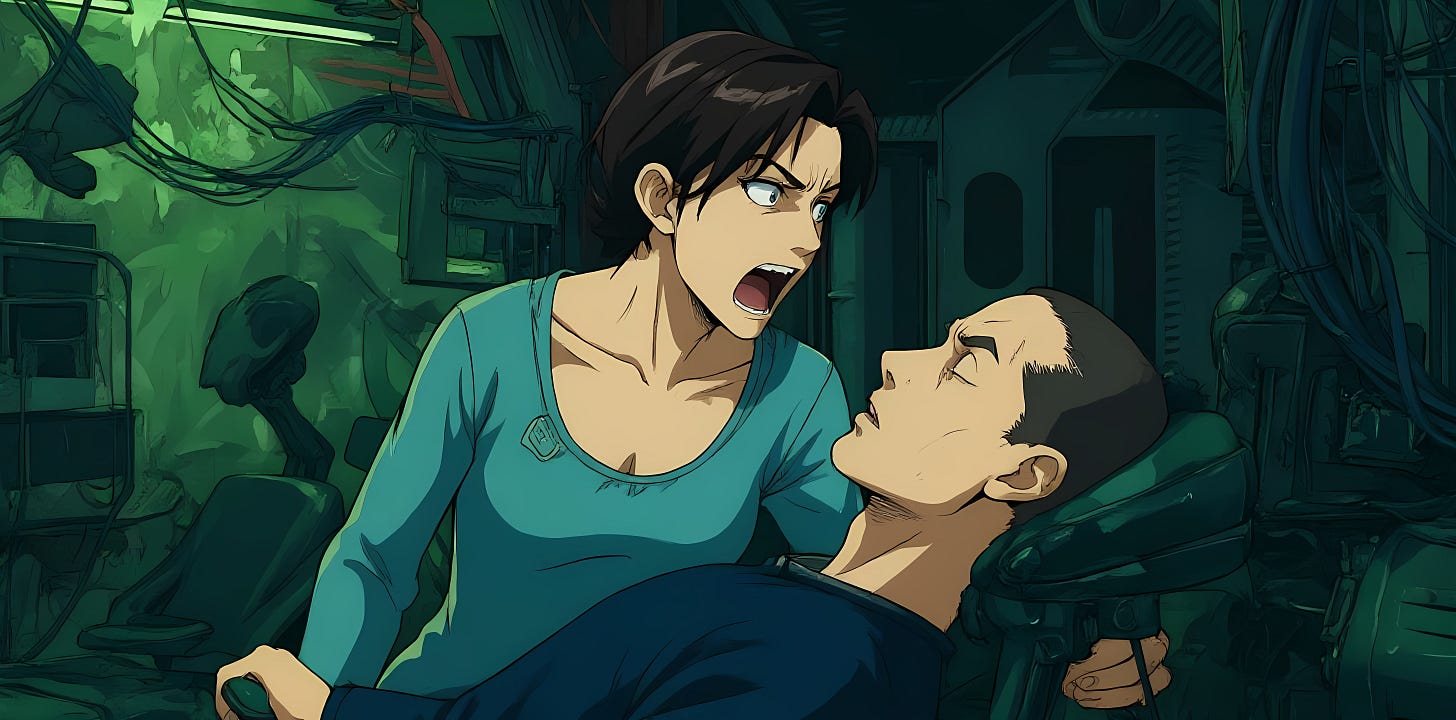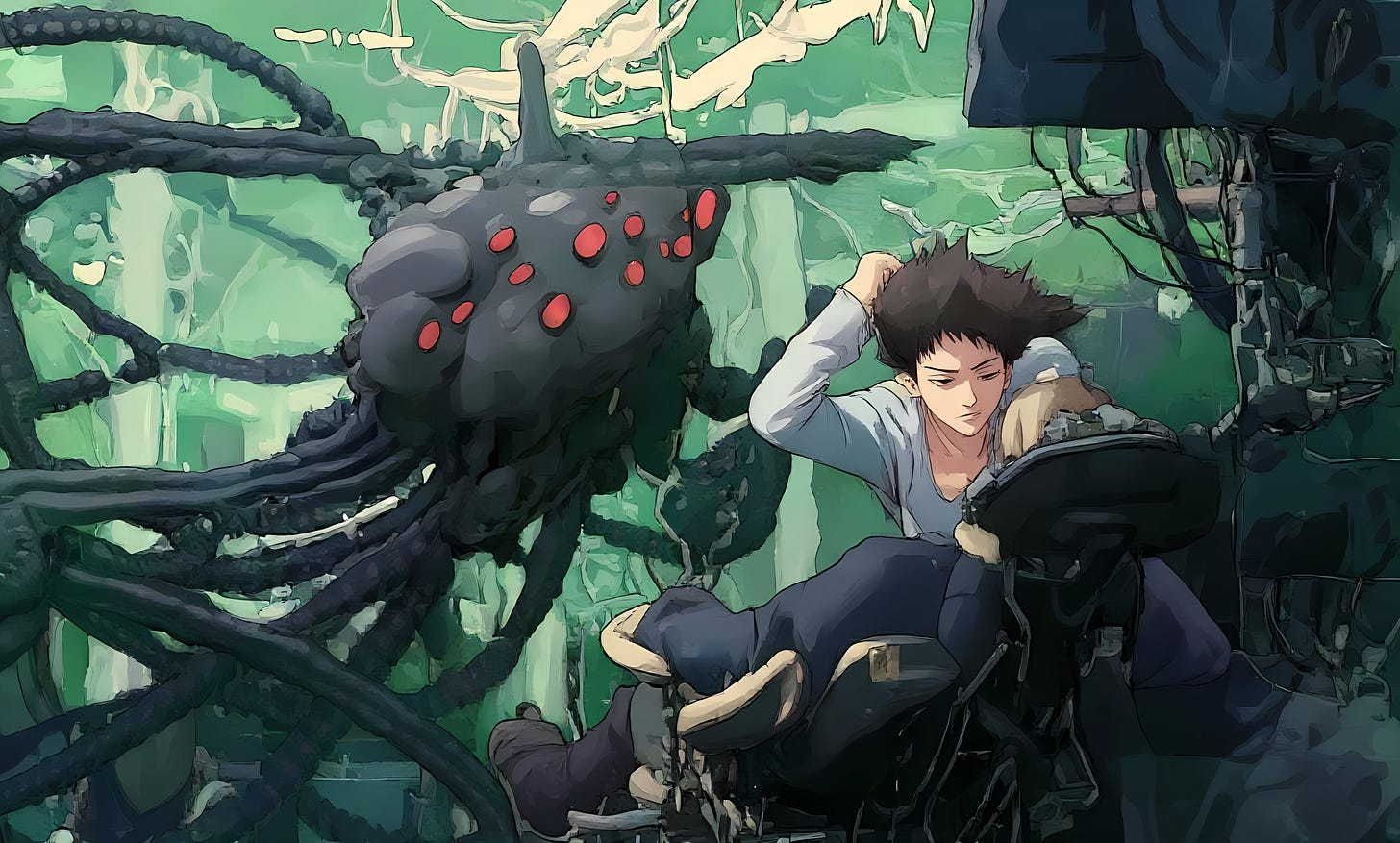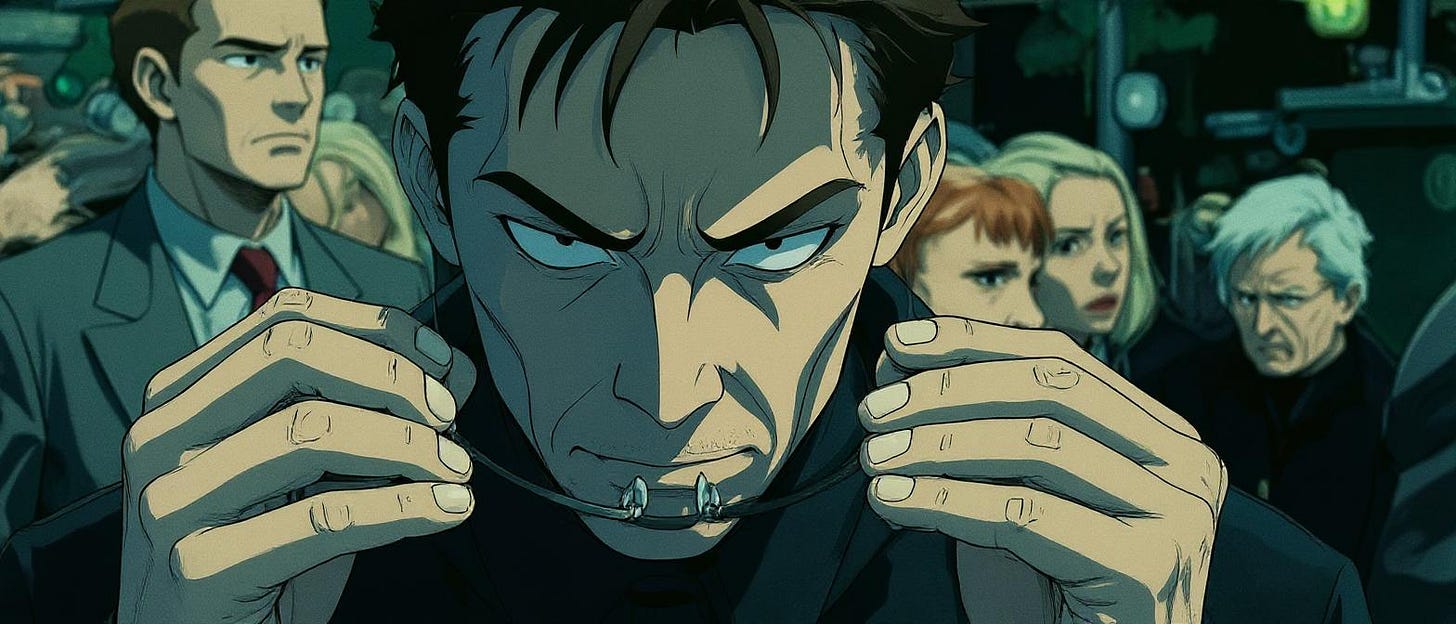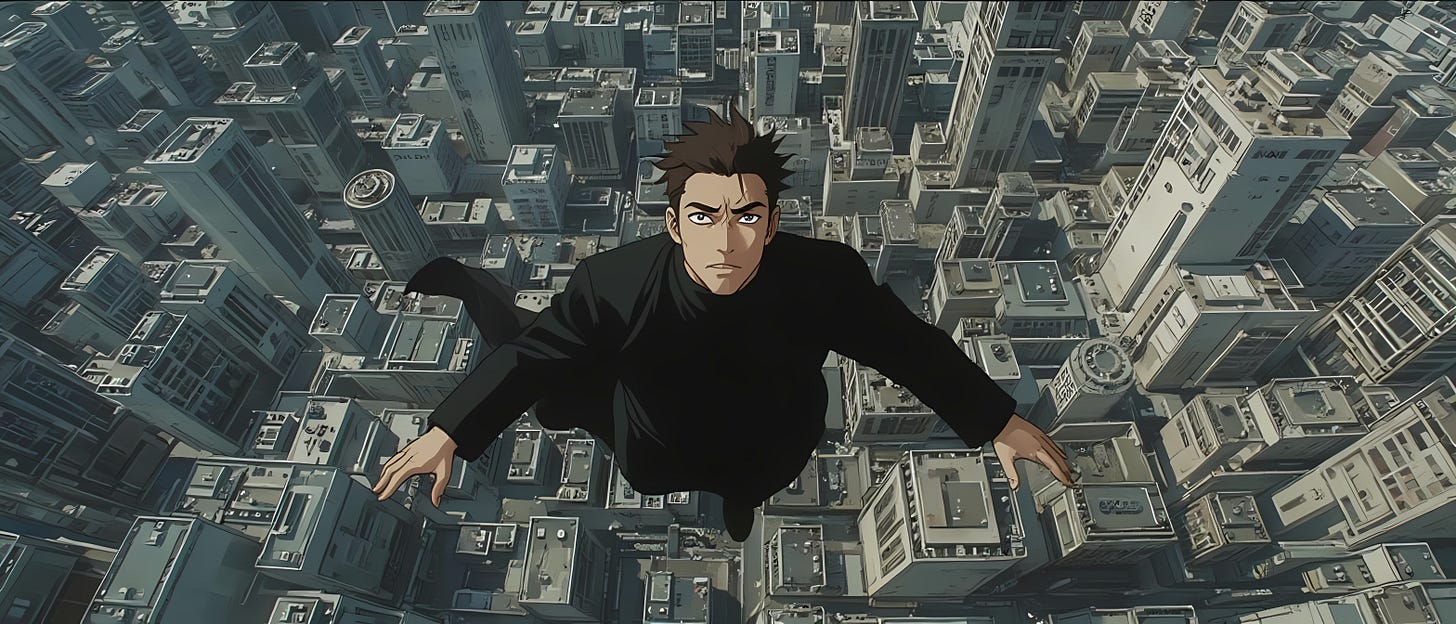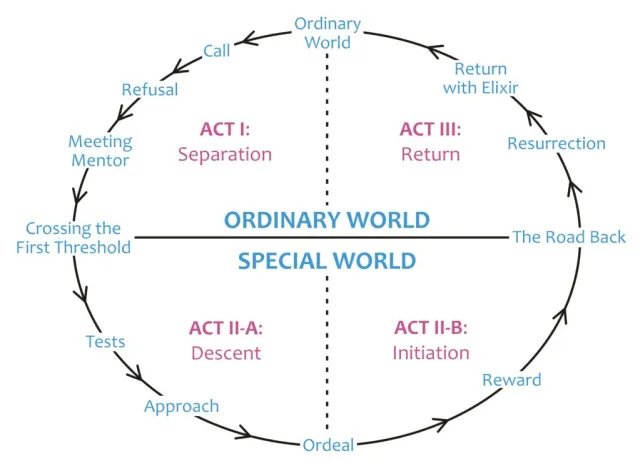In our last issue I introduced you to one of the most important story frameworks of all time: Joseph Campbell’s Monomyth, also known as “The Hero’s Journey”.
Today, we’ll be applying all that we learned about the Hero’s Journey to analyze one of my favorite movies: The Matrix.
For reference, here are the original 17 stages in the Hero’s Journey, as Campbell described them in his book:
With that in mind, let’s map The Matrix to these 17 stages, while, at the same time, we explore Campbell’s explanations of each individual stage.
We’ll also map the 3 distinct sections in the Hero’s Journey –Separation, Initiation & Return– to the classic 3-Act Structure, just like we did last time.
Oh, and just to have some fun along the way, we’ll be converting each scene still into manga style using the fabulous Flux Kontext model hosted on OpenArt.
For that, I’ll simply upload each still from the movie and use the prompt:
convert this still into manga in the style of Ghost in the Shell, full color, slightly green filter, cinematic
Like so:
The new Flux Kontext is FANTASTIC to change any image into a different style.
The simple prompt above gives us this result:
So… ready for it?
Let’s do it!
Act One: Departure
STAGE #1: THE CALL TO ADVENTURE
Campbell's Description:
The hero, existing in a state of normality, receives information or experiences an event that acts as a call to venture into the unknown.
This call can manifest as a blunder, a chance encounter, or a phenomenon that captures the hero's attention, luring them away from familiar paths.
Thomas Anderson, a software programmer leading a double life as the hacker Neo, is at his computer when cryptic messages appear: "Wake up, Neo" … "The Matrix has you”, and, finally, a hint: "Follow the white rabbit."
Shortly thereafter, a couple knocks on his door to buy some kind of illegal program from Neo…
They invite him to go out with them but he refuses… until he sees a white rabbit tattoo on the woman’s shoulder!
Justification:
These mysterious messages, and the synchronistic appearance of the white rabbit, directly disrupt Neo's "situation of normality", his routine existence as a hacker and programmer, and invite him to venture into an unknown world, aligning perfectly with Campbell's definition of The Call to Adventure.
STAGE #2: REFUSAL OF THE CALL
Campbell's Description:
The future hero often initially hesitates or refuses to heed the call.
This refusal can stem from fear, insecurity, a sense of duty, or other reasons that keep the individual bound to their current circumstances.
Campbell notes that such refusal "converts the adventure into its negative", potentially making the hero a "victim to be saved".
Neo hesitates when Trinity first speaks to him at the nightclub, unsure of her intentions.
But a more significant refusal occurs when Morpheus, guiding Neo by phone, instructs him to escape his office building via a high-rise scaffold to evade the pursuing Agents.
Overcome by fear, Neo fails to make the attempt, what leads to him being captured by the agents.
Neo even says: “I cannot do this”, verbalizing the essence of this stage!
Justification:
Neo's acrophobia and the immediate peril cause him to "turn away from the adventure".
This refusal leads directly to negative consequences—his capture and interrogation by Agent Smith—which Campbell describes as a potential outcome of not heeding the call.
STAGE #3: SUPERNATURAL AID
Campbell's Description:
Once the hero commits to the quest, consciously or unconsciously, a protective figure or magical helper often appears.
This mentor figure frequently provides the hero with talismans or artifacts that will assist them.
This aid represents the "benign, protecting power of destiny".
After Neo's capture and the implantation of the "bug", Trinity and her crew physically intervene, remove the tracking device implanted by Agent Smith, and take Neo to meet Morpheus.
Justification:
Trinity is Neo’s magical helper, and Morpheus in his Mentor figure.
Morpheus's guidance, along with Trinity's direct intervention, are the supernatural aid that Neo needs in order to cross the first threshold.
This supernatural aid is pivotal, especially following Neo's initial failure to escape.
The red pill functions as the "talisman" or "artifact" that enables Neo to wake up in the real world.
STAGE #4: THE CROSSING OF THE FIRST THRESHOLD
Campbell's Description:
The hero commits to the adventure and ventures out of their known world into an unfamiliar realm where the rules and dangers are unknown.
This marks the passage beyond the "Guardians of the Threshold".
Neo finally gets to meet Morpheus and he’s presented with a choice:
“You take the Blue pill, the story ends, and you wake up in your bed and believe whatever you want to believe…”
“You take the red pill, you stay in Wonderland, and I show you how deep the rabbit hole goes.”
Neo chooses the red pill, and as a consequence of committing to the Journey, he awakens in the real world.
He finds himself in a pod within the vast human power plant, where he’s is unceremoniously flushed from the system, and subsequently rescued by Morpheus and the crew of the Nebuchadnezzar.
Justification:
This sequence represents a literal and dramatic crossing from the "world of common day" (the simulated reality of the Matrix) into a "region of supernatural wonder" (the desolate real world and the war against the machines).
The real world, with its sentient machines and human harvesting, is the "place of strangely fluid and polymorphous beings, unimaginable torments" that Campbell describes.
STAGE #5: Belly of the Whale
Campbell's Description:
This stage represents the hero's final separation from their known world and self.
The hero is "swallowed into the unknown" and appears to have died, symbolizing entry into a sphere of rebirth and the point of no return.
Neo awakens aboard the Nebuchadnezzar and is confronted with the horrifying truth of the real world—the "desert of the real"—as explained by Morpheus.
He sees the fields of human bodies being harvested for energy.
His profoundly shocked and reacts with disbelief and denial: "I don't believe it. It's not possible."
This sequence culminates with Neo’s physical revulsion, vomiting and passing out, which perfectly encapsulates the meaning of this stage!
Justification:
This is the ultimate point of no return for Neo.
The revelation of the true nature of reality constitutes a symbolic death of his former self and his entire understanding of existence.
He is "consumed with this new reality" , and his visceral reaction underscores the trauma and significance of this passage to the new reality!
Act Two: Initiation
STAGE #6: The Road of Trials
Campbell's Description:
The hero undergoes a series of tests, tasks, or ordeals, often with the aid of the supernatural helper encountered earlier.
The hero typically fails at least one of these tests, which are crucial for learning and growth.
Neo's goes through an intensive training regimen aboard the Nebuchadnezzar, including martial arts training and other skills downloaded directly into his brain. Then, he must fight Morpheus in the “Construct”.
A key trial for Neo in this phase is the "Jump Program", where Neo must leap between simulated skyscrapers.
The crew takes bets on his failing, because some crew members think that if he really is the One, he won’t fail.
After Neo fails the test, Mouse asks: “What does that mean?”
Switch replies: “It doesn’t mean anything.”
To which Cypher adds: “Everybody falls the first time.”
This faithfully reflects the spirit of this stage: the Hero must face several tests –usually 3, or in groups of 3– and he’ll often fail them.
Simply because… everybody falls the first time!
(we all fail our first attempt at anything)
Justification:
These sequences are direct tests of Neo's physical and mental capabilities, specifically his ability to "free his mind" from the perceived limitations of the Matrix.
Morpheus acts as the "supernatural mentor" during these trials.
Side Note: Neo's failure in the jump program helps introduce the "the body cannot live without the mind" concept, which is a key element used in the movie to raise the stakes for the audience!
STAGE #7: The Meeting with the Goddess
Campbell's Description:
The hero experiences a profound, often mystical love, or encounters a figure representing the sum of what can be known.
This figure often embodies a union of opposites –e.g. womb and tomb, good and evil– and may offer unconditional love or profound wisdom.
The goddess "lures, she guides, she bids him burst his fetters".
This stage is embodied in Neo's developing a love relationship with Trinity, and also in his encounter with the Oracle.
Trinity represents a powerful, supportive, and ultimately romantic connection; her unwavering belief in Neo is a constant source of strength for him.
The Oracle, a mysterious and wise woman, provides cryptic but crucial guidance that shapes Neo's understanding of his path and choices.
Justification:
Both Trinity and the Oracle fit Campbell's description.
Trinity’s love and faith in Neo are pivotal, especially at critical junctures.
The Oracle, with her enigmatic pronouncements, guides Neo towards self-discovery, pushing him to comprehend possibilities beyond his current understanding.
Both figures appear at "significant zeniths in the Hero’s quest" and help Neo unlock his full potential.
STAGE #8: Woman as Temptress (Temptation)
Campbell's Description:
The hero encounters temptations, often of a physical or material nature, that threaten to lead them astray from their quest.
This stage represents the revulsion from one's own "sinful" or worldly nature.
While the movie briefly nods to this stage of the Hero’s Journey with the Woman in Red scene, Neo himself does not face a direct "temptress" in the traditional sense.
Instead, the film explores this theme powerfully through the character of Cypher.
Cypher's deal with Agent Smith—to betray Morpheus and the crew in exchange for a comfortable, ignorant, and pleasurable life back in the Matrix—vividly portrays the temptation of illusion and physical comfort over the harsh, difficult truth of the real world.
A more subtle temptation and test for Neo himself is the Oracle's telling him what he wanted to hear all along: that he is not The One.
Justification:
Cypher's arc serves as a stark illustration of succumbing to temptation, the "cheap way out".
It highlights the allure of the material and the desire to escape the hardships of the hero's path.
The Oracle's seemingly misleading words also test Neo's inner resolve and belief.
STAGE #9: Atonement with the Father
Campbell's Description:
This stage involves the hero confronting and reconciling with the ultimate power or authority figure in their life, often symbolized as a father.
It's not necessarily about a literal father, but about overcoming the "ogre-aspect" of this figure and achieving an internal transformation, an abandonment of the ego.
The hero "turns to face the world of specialized adult action".
Morpheus, Neo's primary mentor and a father figure in the movie, is captured by Agent Smith.
Faced with the crew's pragmatic decision to kill Morpheus to protect Zion's codes, Neo makes a pivotal choice: he decides to re-enter the Matrix and rescue Morpheus.
Justification:
When Morpheus is captured Neo is confronted with the now inescapable need to stop doubting himself and take charge of the situation.
This is not a confrontation with Morpheus, but rather with himself since he must now step into the role he’s been so afraid to embrace: the role of The One.
There is no way back now: Neo must prove that he deserves the faith that Morpheus (and Trinity) have always had in him.
Moreover, this is the ultimate test for Neo’s faith in himself, which is one of the main themes of the movie.
Neo's decision to trust himself to save Morpheus against overwhelming odds signifies an internal shift.
He moves from being a follower to an becoming active agent, taking responsibility and acting on belief rather than doubt, thus achieving a form of "atonement" by embracing his destiny.
STAGE #10: Apotheosis
Campbell's Description:
After the trials, there is often a period of divine knowledge, love, compassion, and bliss.
This is a state of god-like realization, where the hero achieves a greater perspective.
It often involves a symbolic death of the old self and the birth of a new, enlightened one.
This stage culminates in Neo's literal death and subsequent resurrection.
After successfully rescuing Morpheus, Neo confronts Agent Smith in the subway.
Though he fights with newfound confidence –"My name... is Neo!"– he is ultimately shot and killed by Smith in the hotel hallway.
But Trinity's declaration of love and her kiss bring him back from the dead.
Upon his resurrection, Neo gains the ability to see the Matrix’s underlying code and control it at will.
Justification:
Neo's literal death and resurrection are the ultimate "death of the old self" and "birth of a new one".
His ability to perceive the underlying code of the Matrix signifies the "greater perspective" and "divine knowledge" of apotheosis.
The doubting Thomas Anderson is gone, and The One is fully realized.
STAGE #11: The Ultimate Boon
Campbell's Description:
The achievement of the quest's goal.
The hero seizes the "treasure" or "elixir" they have been seeking, which can be a physical object, wisdom, or a new state of being.
This is the "decisive victory".
This is Neo's full realization and manifestation of his powers as The One.
This includes perceiving the Matrix’s underlying code, stopping bullets in mid-air, and ultimately defeating Agent Smith by physically entering his code and destroying him from within.
Justification:
The "ultimate boon" for Neo is not a tangible item but the complete awakening of his prophesied abilities and the profound understanding of the Matrix's true nature, granting him mastery over it.
This power is the "elixir" he will use to aid humanity.
Act Three: Return
STAGE #12: Refusal of the Return
Campbell's Description:
Having found enlightenment or bliss in the special world, the hero may be reluctant to return to the ordinary world to bestow the boon upon their fellow humans.
This stage is not explicitly prominent for Neo, whose immediate purpose upon gaining his powers becomes the liberation of humanity.
However, the film explores this concept through Cypher.
Cypher's entire arc is a dark reflection of Neo’s: a desperate "refusal of the return" to the harshness of the real world.
This refusal leads him to betray his comrades for a promised reinsertion into the "ordinary" –though comfortable–world of the Matrix.
His line when negotiating his reinsertion with Agent Smith says it all:
“After 9 years, you know what I realized? Ignorance is bliss.”
This is the ultimate refusal of knowledge, and the responsibility that comes with it.
Justification:
While Neo embraces his return mission, Cypher's character arc serves as a powerful counterpoint, illustrating the potent allure of the "other world" –even an entirely false one– and the temptation to reject the burdens of reality and the hero's responsibilities.
STAGE #13: The Magic Flight
Campbell's Description:
If the boon is won against the will of its guardians, or if the hero is to be brought back from the supernatural realm, the return journey can be a lively and dangerous adventure, often involving pursuit.
After Neo defeats Agent Smith by destroying his code-form, the remaining Agents flee.
Neo must then quickly find an exit –a ringing payphone– to leave the Matrix as the Sentinels are simultaneously attacking the Nebuchadnezzar in the real world.
Justification:
There is a clear element of urgency and danger in Neo's final escape from the Matrix.
He possesses the "boon" –his full power as The One– but must make a swift exit into the real world where Trinity and the entire crew are facing an imminent destruction.
STAGE #14: Rescue from Without
Campbell's Description:
The hero may need to be brought back from their adventure by powerful guides or rescuers, as they may be wounded, weakened, or unwilling to return.
Trinity's declaration of love and her kiss, which act as the catalyst for Neo's resurrection within the Matrix after Agent Smith shoots him.
In the real world, Tank's guidance helps Neo locate the exit phone.
Concurrently, the Nebuchadnezzar firing its EMP weapon disables the attacking Sentinels precisely as Neo exits the Matrix.
Justification:
Trinity's love is the direct and mystical force that "rescues" Neo from death.
The crew's timely deployment of the EMP at the very last moment is a critical intervention to save both Neo and the ship.
STAGE #15: The Crossing of the Return Threshold
Campbell's Description:
The hero returns to the world of common day and must integrate the wisdom gained from the quest into their life and share it with their society.
This can be a difficult transition.
Neo, back aboard the Nebuchadnezzar, is now fully actualized as The One.
The final scene involves a phone call made from within the Matrix, where he delivers a message to the machines, promising to show people "a world without you, a world without rules and controls, without borders or boundaries. A WORLD WHERE ANYTHING IS POSSIBLE."
Justification:
Neo has returned from his symbolic –and literal– death and resurrection, bringing back with him the "elixir" of his mighty power over the Matrix.
The final scene on the phone shows his commitment to use this newfound wisdom and power to free others from the Matrix.
STAGE #16: Master of Two Worlds
Campbell's Description:
The hero achieves a balance between the material and spiritual worlds, becoming comfortable and competent in both the ordinary and the special realms.
This often involves transcending dualities.
Neo's final actions in the film demonstrate this mastery.
He confidently walks into the Matrix, no longer bound by its laws, to deliver to the machines a powerful message.
He understands both the illusion of the Matrix and the harsh reality of the war against the machines, and can now operate with unprecedented power in both worlds.
Justification:
Neo can navigate the "chaos realm" (the Matrix, now subject to his will) and the "normal order realm" (the real world, where the fight continues).
The film inverts the typical dynamic, as the "real" world is chaotic and dangerous, while the "simulated" world of the Matrix is orderly but oppressive.
Neo is no longer a victim of the Matrix but a conscious agent within it.
STAGE #17: Freedom to Live
Campbell's Description:
Having conquered their inner demons and external foes, and often having overcome the fear of death, the hero achieves a state of liberation.
They can live in the moment, without fear of the future or regret for the past. This stage often relates to the eternal spirit.
Neo's concluding flight into the sky is a powerful symbol of ultimate liberation and boundless potential.
His promise to show humanity "a world where anything is possible" reflects this newfound freedom and his focus on creating a new future for all humankind.
Justification:
Having literally conquered death and his own self-doubt, Neo embodies this freedom.
His attention is not on past limitations but on the future possibilities he can unlock for himself and for humanity, free from the illusion and constraints of the Matrix.
And with that, we have covered all 17 Stages of the classic Hero’s Journey as originally presented by Joseph Campbell in “The Hero With A Thousand Faces”.
As you can see, The Matrix reveals a strong alignment with Campbell’s 17 stages, though some stages find a more metaphorical or condensed representation.
For instance, concepts like the "Meeting with the Goddess" are not embodied by a single divine entity in The Matrix, but rather reflected in the crucial roles of Trinity's love and the Oracle's enigmatic wisdom.
Similarly, the "Refusal of the Return" is more vividly portrayed through Cypher's tragic desire to re-enter the Matrix's illusion than through any reluctance on Neo's part to fulfill his destiny.
This highlights an important aspect of applying such a dense mythological framework to a contemporary film: the spirit and thematic resonance of a stage are often captured even if a literal, one-to-one scene correspondence is not always present.
This also highlights an important aspect of all story frameworks: they are to be used as a guide to craft powerful stories, never as a rigid structure that cannot be bent, or even broken!
As screenwriters, we must remain flexible to serve the purpose of our stories.
That’s why it’s quite common to find that, in practice, some of these archetypal moments might merge together, or only appear as symbolic representations within the story, or be portrayed by secondary characters.
With that precaution in mind, I hope you can see now how useful it can be to use these 17 stages as a guide during the screenwriting process!
As mentioned in the last issue, I wanted to start with the original 17 stages of the Hero’s Journey because I feel you’ll benefit greatly from having at least a basic notion of what each of these stages entails.
In the next issue, I’ll be teaching you a simplified version of the Hero’s Journey that’s most commonly used by screenwriters: Chris Vogler’s 12-Stage Writer’s Journey.
Vogler’s version is entirely based on Campbell’s Hero’s Journey, but he has changed some of the names and terminology used in the stages, merged a few, and in general, made the framework simpler, more flexible, and easier to adapt to different movie genres.
For now, I’ll leave you with the 12-Stage Writer’s Journey diagram, so you can start reflecting on its differences from Campbell’s model:
See you next week!
Leonardo
P. S. Having a blast with Flawlessly Human?
Please take a couple of minutes to support my work by sharing it with your friends and colleagues:
You can also share this particular issue using the button below:


